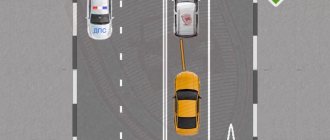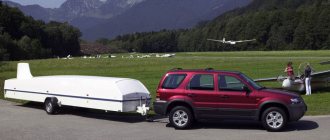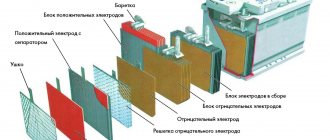Good afternoon, dear reader.
In most cases, passenger cars are operated without trailers. Therefore, car owners who only occasionally transport cargo on a trailer eventually forget the points of the traffic rules governing movement with a trailer.
This article discusses traffic regulations related to towing trailers:
- What is a trailer?
- Categories of driving license for transporting a trailer.
- Documents for transporting a trailer.
- MTPL insurance for trailer.
- Speed of a vehicle with a trailer.
- Sign: Driving with a trailer is prohibited.
- Transporting people in a trailer.
- Lighting devices on the trailer.
- Road train lamp when towing a trailer.
- Is it possible to transport several trailers at the same time?
What is a trailer?
The concept of “trailer” is discussed in paragraph 1.2 of the traffic rules:
“Trailer” is a vehicle that is not equipped with an engine and is intended to be driven in conjunction with a power-driven vehicle. The term also applies to semi-trailers and trailers.
Please note that from the point of view of traffic regulations, a trailer is a vehicle .
For example, this means that a collision between a trailer and an object constitutes a traffic accident.
A car together with a trailer is called a road train:
“Road train” is a mechanical vehicle coupled to a trailer(s).
This concept can be applied to both trucks and cars with trailers.
Subcategory CE
We have decided which trailer can be towed with a category C license - only one whose weight does not exceed 0.75 tons.
Subcategory CE is exactly the same as the main category C. Their only difference is that a trailer can be attached to such a cargo transport, the maximum permissible weight of which can be more than 0.75 tons.
Many car enthusiasts are interested in the question: is it possible to drive with a trailer? The CE category provides such a right.
Driving license categories for transporting a trailer
Let's look at the driver's license categories that allow you to tow a trailer:
| Category | Trailer that can be towed |
| IN | 1) permissible maximum weight (PMM) up to 750 kg or 2) PMM more than 750 kg, but does not exceed the weight of the machine without load and the mass of the train does not exceed 3500 kg. |
| BE | any trailers |
| WITH | RMM up to 750 kg |
| SE | any trailers |
| D | RMM up to 750 kg |
| DE | any trailers |
Note. The table is compiled on the basis of Article 25 of the Federal Law “On Road Safety”.
Thus, a trailer with a permissible weight of 750 kg or less can be attached to absolutely any vehicle and this will not require an additional category.
As for category B, in some cases it allows you to “drag” heavier trailers:
For example, the permissible maximum vehicle weight is 2,000 kg, the vehicle's unladen weight is 1,500 kg. In this case, you can add a trailer with a permissible weight of up to 1,500 kg to the car and no additional category will be required.
Driver's license categories
If you want to transport heavier trailers, you should undergo training and pass exams for category E:
- theory;
- autodrome (4 exercises);
- city.
Note. The theoretical exam is taken using the same set of tickets as the exam for the main category. For example, for category CE the CD set is used, for BE - ABM.
ABM TicketsCD Tickets
How to open a new category?
Types of trailers and their designations
Sometimes it is possible to drive a car with a tow if only category “B” is available. For a better understanding of the situation, you should understand the acceptable category for driving a trailer:
- O1 – light units weighing up to 0.75 tons;
- O2 – trailers 0.75-3.5 t;
- O3 – heavy, not exceeding 10 tons;
- O4 – super-heavy equipment from 10 tons.
Load capacity, curb and gross weight of the vehicle
The topic of trailer and operating conditions carries with it a range of terminology:
- A trailer is a vehicle that is not equipped with a motor;
- A towing vehicle is a vehicle used as a tug;
- Light trailers – trailers with a full load of up to 750 kg;
- Heavy – trailers from 750 kg with brake mechanisms;
- Gross weight: vehicle + cargo;
- Curb weight – the weight of the tug;
- Load capacity – max. weight supported/transported by the trailer;
- Permitted maximum load: vehicle weight + driver + passengers. Set by the manufacturer as the maximum allowed.
Documents when transporting a trailer
Clause 2.1 of the traffic rules:
2.1. The driver of a motor vehicle is obliged to:
2.1.1. Carry with you and, at the request of police officers, hand over to them for verification:
- registration documents for this vehicle (except for mopeds), and if there is a trailer, also for the trailer (except for trailers for mopeds);
That is, in addition to documents for the car, the driver must have with him a trailer registration certificate .
Naturally, the trailer itself must have numbers (registration plates):
2. On motor vehicles (except for mopeds, trams and trolleybuses) and trailers, registration plates of the appropriate type must be installed in the places provided for this purpose, and on cars and buses, in addition, a license card must be placed in the lower right corner of the windshield in prescribed cases.
Where to look for information
It also happens that a driver purchases a trailer, but does not know what the maximum permissible weight is in his particular case. What indicators should the maximum weight not exceed, and will he have to make changes to his current license due to the purchase of the wrong trailer?
There are several main sources here.
- VIN code plate
. Exactly by car. Yes, the same one that allows you to get a number of useful information about the car and its owners. The location may vary depending on the model and manufacturer, but it should be present. There are 4 numbers at the bottom of the plate, where different weight indicators are written. These numbers are described in detail in this article, so just open the link; - Specifications
. The trailer manufacturer is also required to indicate the relevant information in the documents for the manufactured device. Therefore, it will not be amiss to look at the attached papers and documents; - Products webpage
. You can open the website of the manufacturer or seller of your trailer and study all the information about the model presented there; - The endless expanses of the Internet
. Everything here is very clear. But it is better to choose official sources of information.
No one hides such data, and therefore it is extremely easy to find out. You just need to set the appropriate goal.
MTPL insurance for trailer
Article 4 of the Federal Law “On Compulsory Motor Liability Insurance” says the following:
3. The obligation to insure civil liability does not apply to owners of:
e) trailers for passenger cars belonging to citizens;
That is, for a personal trailer for a passenger car, registration of compulsory motor liability insurance is not required .
However, in all other cases, trailer insurance must be taken out. In 2021, a separate trailer policy will not be issued. Information about the use of a trailer is entered into the car insurance (check the box). However, the cost of insurance if you have a trailer can increase by up to 40 percent, although for some trailers it remains unchanged.
You can calculate the cost of a policy for using a trailer using the following calculator:
OSAGO calculator
For trucks
There are slightly different rules in force here, defined by Federal Law No. 257 “On Highways and Road Activities” and PP No. 272 of April 15, 2011.
Appendices No. 1 and 3 indicate what maximum weight and dimensions are determined for moving cargo in a trailer using freight transport.
The first application determines the permissible weight based on the type of vehicle, loading platform and number of axles.
| Truck type/platform | Number of axles/permissible maximum weight (tonnes) |
| Single cars | 2/18 |
| 3/25 | |
| 4/32 | |
| 5/35 | |
| Semi-trailers and trailed road trains | 3/28 |
| 4/36 | |
| 5/40 | |
| 6 and more/44 |
| Limit dimensions according to Appendix No. 3 | |
| Length (meters) | Single vehicle and trailer (12) |
| Road train (20) | |
| Body width (meters) | General requirements (2.55) |
| Isothermal vans (2.6) | |
| Truck height (meters) | No more than 4 |
Any truck driving onto a Russian road must weigh no more than 44 tons, be no more than 20 meters in length and 4 meters in height.
Speed of vehicle with trailer
The traffic rules set speed limits only for passenger cars with a trailer :
- 90 km/h - on the motorway.
- 70 km/h - outside the populated area.
- 60 km/h - in a populated area.
- 20 km/h - in residential areas, bicycle areas and courtyard areas.
Please note that we are talking about the type of vehicle (passenger car), and not the category of vehicle (B).
For example, if a small truck (Gazelle) is traveling with a trailer, then these restrictions do not apply to it. That is, a Gazelle with a trailer can travel 110 km/h on the highway and 90 km/h outside the city.
The same applies to small pickup trucks, which often resemble cars in appearance.
That is, restrictions exist only for passenger cars. Other types of vehicles (trucks, buses) can travel at the same speed with a trailer as without a trailer.
Fines for violations
Although driving with a trailer when overloaded is not specified in the Code of Administrative Offences, a fine can still be issued under the following articles of the code:
- 12.21 - when the rules of towing and transportation of goods are violated (fine - 500 rubles);
- 12.21.1 part 11 - when driving through sign 3.12 with an overloaded total weight (fine 5 thousand rubles);
- 12.21.1 part 9 - in case of special understatement of the cargo on documents by the sender: in this case, the driver risks running into a fine for overloading of 5 thousand rubles, an official - 25-35 thousand rubles, and an organization - 250-400 thousand rubles.
Transportation rules in some cases provide for special permission.
It is permissible to exceed the maximum speed only by 20 km/h (Part 2 of Article 12.9 of the Administrative Code).
Since the trailer is part of a moving vehicle and cannot be driven without it, only one fine is issued.
Speed limits when driving passenger cars with towed devices are established by Section 10 of the Traffic Regulations.
Article 12.9 of the Code of Administrative Offenses determines the amount of fines taking into account the recorded speeding.
| Exceeding (km/h) | Fine (rubles) or other sanction / amount of sanction for photographic recording | Part of the article |
| > 20 and ≤ 40 | 500/500 | Part 2 |
| > 40 and ≤ 60 | 1000–1500/1000 | Part 3 |
| > 40 and ≤ 60 (repeat) | 2000–2500/2000 | Part 6 |
| > 60 and ≤ 80 | 2000–2500 or deprivation of rights for 4–6 months/2000 | Part 4 |
| > 80 | 5000 or deprivation of rights for six months/5000 | Part 5 |
| > 80 (repeat) | Deprivation of rights for a year/5000 | Part 7 |
If the fine is paid within 20 days from the date of imposition of the penalty, the driver will be able to save half the amount (Part 1.3 of Article 32.2 of the Administrative Code). The assignment does not apply if there is a repeated violation.
When a driver driving a vehicle with a trailer passes under sign 3.7, liability will arise under Part 1 of Article 12.16 of the Administrative Code. The violator faces a fine of 500 rubles.
The sign will not be valid only under two circumstances:
- transport belongs to citizens who live, work or are in the area covered by the sign;
- for postal transport.
In addition to the above situations, you may be fined in other cases:
- there is no information about the trailer in the MTPL policy - 500 rubles (Federal Law No. 40);
- Vehicles are faulty - 500 rubles (Article 12.5 of the Code of Administrative Offenses), this includes cases of failure of lighting fixtures;
- Category “E” is not open - 5 thousand rubles (Article 27.12 of the Administrative Code).
No trailer driving sign
The traffic rules include a sign that prohibits driving with a trailer:
3.7 "Driving with a trailer is prohibited." It is prohibited to drive trucks and tractors with trailers of any type, as well as tow motor vehicles.
Please note that in this case we are also talking about the type of vehicle (truck or tractor), and not the category of the vehicle.
That is, this sign prohibits movement:
- Any trucks (categories B, C) with trailers.
- Any tractors with trailers.
- Towing of motor vehicles.
The sign does not prohibit the movement of cars or buses with trailers.
Traffic rules
So, how to drive with a trailer? First of all, you should pay attention to the fact that a car equipped with an additional cargo platform becomes less agile. In addition, it takes more time to gain speed, and the braking distance increases
These features must be taken into account when driving onto public highways and performing maneuvers on them.
You must remember the following rules:
- Driving next to heavy vehicles is especially dangerous. The latter create strong air currents that affect the handling of other vehicles. The trailer may move to the side under such influence.
- The second important nuance that should be noted is the increased rotation angle. Its size directly depends on the distance from the towbar to the rear of the trailer.
- The third problem faced by drivers driving a car with a trailer is the braking process when making turns. In such circumstances, the loading platform pulls the vehicle to the side. In some cases, when a turn is made at high speed, the towed structure may simply come off, which increases the risk of an accident.
If we summarize the information given earlier, it turns out that when driving a car equipped with a carriage, you need to pay attention to the following nuances:
- current trailer speed;
- increased turning angle and length of the vehicle.
Taking these characteristics into account ensures proper vehicle control.
Moving backwards
The most difficult maneuver with a trailer is moving backwards.
To perform such a maneuver, first of all, you need to take a convenient and comfortable position. In particular, the driver must obtain the most optimal viewing angle and maintain access to all machine controls. Most often, when moving backwards, beginners take a position of half a turn. You can monitor the situation in this position through the rear window. This position is not suitable if the trailer is equipped with an awning.
You can start maneuvering only if the car and the loading platform are on the same line. Another important nuance concerns the direction: in order for the trailer, for example, to turn to the right, you need to move back to the left.
The maneuver is performed as follows:
- The trailer turns in the direction in which the driveway is located. The car is moving in the opposite direction.
- As soon as the platform is in the desired position, the steering wheel turns in the opposite direction. The movement does not stop, since the car and trailer must again form a straight line.
When performing such a maneuver, it is important to maintain the minimum possible speed and not apply the brakes too much.
Transporting people in a trailer
Paragraph 22.8 of the traffic rules:
22.8. It is prohibited to transport people:
- outside the cabin of a car (except for cases of transportation of people in the back of a truck with a flatbed or in a van), tractor, other self-propelled vehicles, on a cargo trailer, in a caravan trailer, in the back of a cargo motorcycle and outside the seating areas provided for by the design of the motorcycle;
That is, transporting people in a cargo trailer is prohibited .
Design specifics
Any vehicle must be registered no later than 10 days from the date of purchase. For registration, you can apply to any registration department of the traffic police, regardless of the applicant’s place of residence or region of stay.
The rules for registering trailers in 2021 are regulated by Decree of the Government of the Russian Federation dated December 21, 2019 No. 1764. Regardless of the number of axles, vehicles must be registered with the state traffic police authorities, while persons who have a driver’s license with an OSAGO do not need to purchase an additional OSAGO policy directly for it ( Clause 3, Article 4 of the Federal Law of April 25, 2002 N 40-FZ On Compulsory Motor Liability Insurance).
Trailer lights
Paragraph 19.1 of the traffic rules:
19.1. In the dark and in conditions of insufficient visibility, regardless of the road lighting, as well as in tunnels, the following lighting devices must be turned on on a moving vehicle:
- on trailers and towed motor vehicles - side lights.
The side lights on a trailer must be turned on in the following cases:
- in the dark;
- in conditions of poor visibility;
- in the tunnels.
How is the category calculated?
In order to calculate the category of transport, it is necessary to take into account the following data:
- Vehicle weight.
- Dimensions of the machine.
- How many wheels?
- The speed that a vehicle can reach.
Parameters such as acceleration time and braking distance also depend on these data.
Road train lamp when towing a trailer
8. The following identification marks must be installed on vehicles:
“Road train” - in the form of three orange lights located horizontally on the roof of the cab with gaps between them from 150 to 300 mm - on trucks and wheeled tractors (1.4 t class and above) with trailers, as well as on articulated buses and trolleybuses;
Road train lights are installed only on the following types of vehicles:
- on trucks with trailers (regardless of category);
- on wheeled tractors heavier than 1,400 kg with trailers;
- on articulated buses;
- on articulated trolleybuses.
In this case, we are again talking about the type of vehicle:
For example, a pickup truck or a Category B van that is towing a trailer must have these lights installed.
On the other hand, on a bus that pulls a regular cargo trailer, a road train light is not required.
Towing a vehicle with a flexible hitch
In this towing, the connecting link is a nylon or steel cable.
Advertisement
Rules for towing a car with a flexible hitch:
- The length of the cable should be no more than 4 - 6 meters;
- The tow rope should not dangle along the road or touch it;
- To visually mark the cable, 2 flags measuring 215 × 200 mm are used. They are depicted as white and red stripes diagonally 50 mm wide;
- The driver must be behind the wheel in order to keep the trajectory set by the distance;
- If the towed vehicle has broken steering and/or brake systems, this type of towing is prohibited;
- Do not tow on slippery roads.
The cost of registering trailers for cars
The price for issuing certificates of registration of trailers for passenger cars this year is 500 rubles
Please note that you can obtain such a registration certificate for only 350 rubles if you register it using the government services portal via the Internet. In this case, you will be given a discount of thirty percent of the nominal value
Other expenses:
- the price for assigning a license plate is 1,500 rubles, with a discount - 1,050 rubles;
- for making changes to a previously issued document you will pay 350 or 245 rubles;
- for issuing a new trailer passport to replace the lost old one - 800 rubles. or 560 rub.;
- for issuing a special certificate that certifies compliance with safety requirements - 800 rubles. or 560 rub.
Registration using the government services portal
What cars can be driven with category C1
If you want to get a good discount (30% of the nominal cost of the registration service is received by those who register a trailer between the beginning of 2021 and the beginning of 2021 according to Article No. 333.35, paragraph No. 4 of the Tax Code), go through the process of obtaining a registration document using the government services portal.
How to register a trailer via the Internet:
- Open the official government services website in your Internet browser. It is located at www.gosuslugi.ru.
- Register on the site if you have not yet performed any actions with the portal, or log in if you have registered previously.
- Go to the vehicle registration section (page address www.gosuslugi.ru/10059) and select the “Vehicle registration and issuance of documents” item.
- Fill out all the required fields of the application that appears on the screen in front of you, and double-check that the data you filled in is correct.
- On the next page, select the department of the State Traffic Inspectorate that is located near your place of residence, and set the time from the suggested time at which it would be convenient to visit the specified government agency.
- After a short wait, your application will be reviewed and the result will be communicated separately (eg by email). The response from the state inspectorate will indicate whether the application will be accepted or whether something needs to be added, altered or corrected. In the second case, you need to make adjustments as quickly as possible and submit the application again via the Internet for approval.
- If the response from the traffic police is positive, you should pay by bank transfer (the portal will indicate how to do this) for the trailer registration service with a thirty percent discount.
- At the time indicated on the portal, you need to arrive together with the registered trailer to the selected traffic police department to receive a document of the established form.
Video about trailer registration
If registration via the Internet does not suit you, collect all the documents described above, take the amount required to pay the fee and go to the state traffic police department.
Good to know
You should know the features of driving a car with a trailer.
A loaded trailer significantly reduces acceleration speed and increases braking distance (especially when the trailer is not equipped with a service braking system).
This must be taken into account when braking or overtaking.
Braking should be smooth and without jerking, the distance to the car in front should be increased, the speed before the turn should be reduced, and the turns themselves should be taken, so to speak, “pull-up”.
At high speeds, sharp turns, even at a slight angle, cause the trailer to sway violently.
Difficult parking and reversing, reduced maneuverability, poor rear visibility (with large trailer dimensions).
Strong winds can overturn a lightweight trailer with a large bed area.
Be careful and follow the traffic rules!
There are many nuances when using a trailer.
You can find a lot of information on the Internet on the following issues: • How to properly load a trailer? • What can be transported in a trailer? • How much will fuel consumption increase when using a trailer? • Do winter/summer tires on a trailer need to be replaced? • Do I need to register a trailer with the traffic police? • Can a trailer be insured?
If you still want to use a trailer, here are a couple more tips for the future, just so you don’t forget: • The dimensions of the trailer should not exceed the capacity of the storage location and the gate through which it will have to be delivered to the storage location. • There must be a spare tire on the car, and therefore on the trailer too. And in order not to carry two spare tires, you can use one standard size of wheel hubs both on the trailer and on the car.











